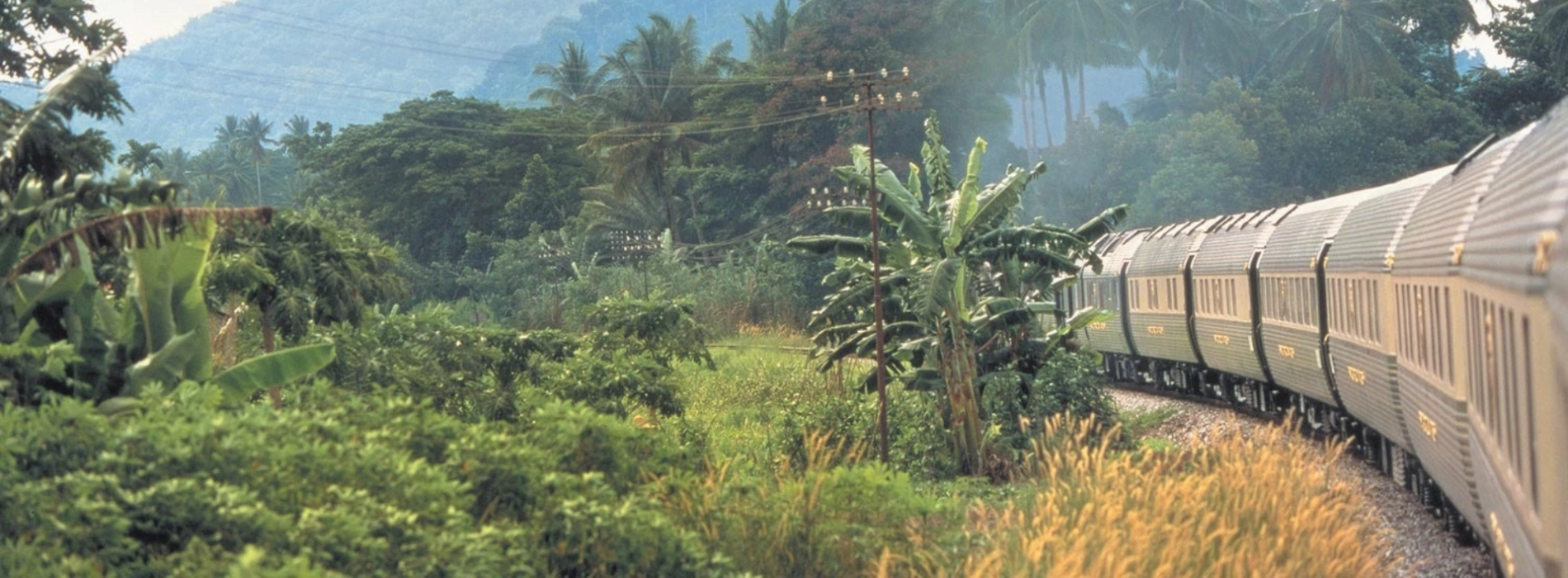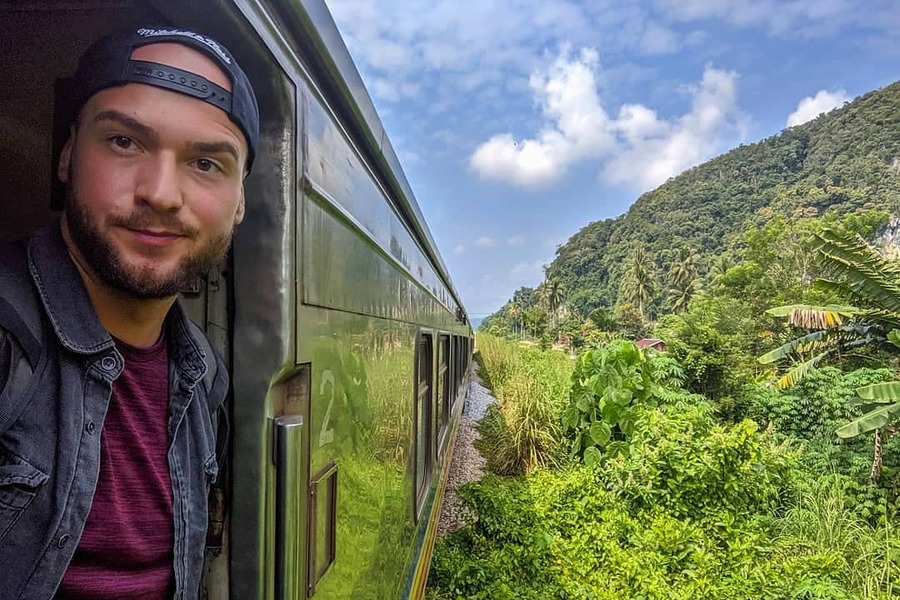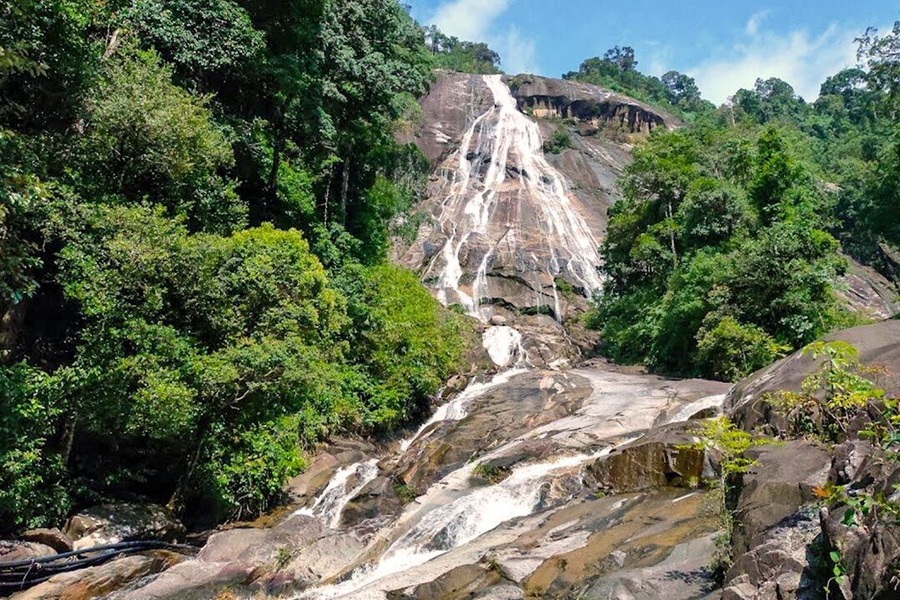
Forget bullet trains, Malaysia Jungle Railway is your ticket to stepping into a travel documentary. Officially the East Coast Line (ECRL), on this journey, you’ll uncover the beauty and rich cultural heritage of Malaysia’s lesser-travelled corners. Let’s take a deeper look at it with Asia King Travel.

The natural scenery of Eastern Malaysia slowly unfolds before your eyes
Stretching for about 526 kilometres, the East Coast Line Malaysia, affectionately known as the Jungle Railway, links the small town of Gemas in the south to Tumpat, right near the Thai border. Despite its name, the tracks only meet the coastline at one end. Most of the journey weaves through the country’s untamed interior, threading past rainforests, rural villages, and limestone mountains that feel a world away from Malaysia’s big cities.
This historic route dates back to the British colonial era, with construction taking place between 1910 and 1931. Originally built to move freight across the peninsula, it quickly became a lifeline for remote communities. Locals even gave it the nickname “Golden Blowpipe”, a nod to the hunting tools of the indigenous Orang Asli people whose homelands the train passes through. Over a century later, the Jungle Railway is still chugging along. Slower than modern lines, perhaps, but rich with heritage and atmosphere.
One of the most breathtaking stretches of this Malaysia train journey runs between Gua Musang and Kuala Lipis Here, the train glides past dense tropical forest. The scenery feels wild and untouched, with each bend in the track revealing another postcard-perfect view. Many travelers say this is where you truly feel the “jungle” in Malaysia Jungle Railway.
Further along the route, the train crosses Guillemard Bridge, an impressive steel truss bridge spanning the Kelantan River. Built in 1925 during the British colonial era, it was partially destroyed during World War II and painstakingly restored in 1948. Today, it remains fully operational, a striking reminder of early 20th-century engineering and a historic landmark in its own right.

Guillemard Bridge is the oldest bridge in Malaysia that is still in use
A stop at Dabong is a treat for nature lovers. This small, laid-back town serves as the gateway to Gunung Stong State Park, home to the majestic Jelawang Waterfall, as well as dramatic limestone caves and forest trails. It’s the perfect spot to break up your journey and explore Malaysia’s wild interior on foot.
Between these key highlights, the Jungle Railway offers a constantly changing backdrop. Thick rainforest giving way to rural villages, paddy fields shimmering under the sun, palm plantations stretching to the horizon, and quiet settlements tucked far from the main roads. It’s a moving window into the heartlands of Malaysia’s east coast, where life still moves to the gentle rhythm of the land.
Suggested for you: Malaysia Trip 9 days: Discoveries of Tropical Jungles Malaysia
The Jungle Railway runs on a single-track line, which means trains traveling in opposite directions must pass each other at designated stations. This old-school system adds a certain charm to the journey, but it also means timing is everything. If one train is delayed, the knock-on effect can ripple along the route.
Travelers have two main options for riding the Jungle Railway. For those covering long distances, the night sleeper trains (such as the Ekspres Rakyat Timuran) offer reclining berths and even a restaurant car, making the journey more comfortable for an overnight ride from Johor Bahru to Tumpat.
Daytime shuttle trains are a travelers' favorite. These modern, air-conditioned diesel multiple units run between key points on the route, though their upright seats can make long trips less relaxing.

Tourists often take the train during the day so they can enjoy the scenery outside
Be aware that there’s no restaurant car onboard. The solution is pack some snacks, or do as the locals do and pick up treats at the station stops along the way. It’s not just a way to stay fuelled, but another chance to taste the flavours of Malaysia as you travel.
Tumpat to Dabong: Starting in Tumpat, right near the Thai border, the Malaysia train journey eases into motion with the soft clatter of wheels on track. It’s a gentle introduction to train travel in Malaysia with historic bridges, jungle-covered hills, and charming villages unfolding outside your window.
The early morning light spills over the Kelantan River, and before long you are crossing Guillemard Bridge, a century-old steel giant that has carried trains across these waters since the 1920s. Villages appear in quick flashes with wooden houses on stilts, children waving from the roadside, and motorbikes buzzing lazily along dusty paths.
Not far from here, the train rolls into Dabong, a sleepy riverside stop that hides a wild secret. Just beyond town lies Gunung Stong State Park, home to jungle trails, limestone caves, and the thunderous Jelawang Waterfall. Even if you are not hopping off, you will feel the landscape change as the rainforest begins to close in around the tracks.

But you should get off the train and spend plenty of time at Gunung Stong
Dabong to Kuala Lipis: The journey south through Gua Musang is a highlight in itself. Towering limestone cliffs rise dramatically from the jungle floor, rivers snake through emerald valleys, and mist clings to the treetops in the morning hours. This stretch feels untouched and almost cinematic, as if you have stepped into an old adventure film. Between stations, the train slows to let you drink in the view, one of the pure joys of this route.

Are we in a Ghibli movie?
Past Kuala Lipis, the scenery begins to soften. The dense jungle gives way to rolling hills, palm plantations, and neat rows of paddy fields. The towns here carry a quiet colonial charm, with old shop houses and weathered train stations that look like they belong to another time. Locals hop on and off with baskets of produce, chatting easily with fellow passengers, a reminder that this railway is still a lifeline for communities far from Malaysia’s highways.
Finish in Gemas: As the train approaches Gemas, the southern gateway to the Jungle Railway, you can feel the shift. The rural calm slowly fades into busier towns, and soon the line connects with Malaysia’s West Coast route. By now, you have spent hours watching the country unfold through your window, with mountains, rivers, jungles, and villages, and it is hard not to feel a little nostalgic as the pace of life picks up again.

Gemas is at the railway junction between the Malaysian west and east coast rail lines
Starting from the north is best enjoyed on local daytime services. The sleeper train isn’t ideal for jungle views, as the most scenic stretch passes at night. However, it’s a handy option if you’re in Kota Bharu and need to reach Singapore by the next day.
Consider breaking up your journey with a stop in Kuala Lipis. Once the state capital of Pahang, this charming riverside town is full of colonial-era architecture and a laid-back atmosphere that makes it perfect for a slow, restorative pause before continuing your trip.
Booking tickets is easiest through the KTMB app, where you can reserve your seats in advance and board using a QR code. It’s quick, efficient, and saves you the hassle of queuing at the station.
If your route takes you through Jerantut, think about making a detour to nearby Taman Negara. This ancient rainforest is one of Malaysia’s natural treasures.
Malaysia Jungle Railway is a journey that invites you to connect with the heart of Malaysia in a way few other experiences can. Are you ready to make this unforgettable adventure? Let us handle the details. Contact Asia King Travel to start planning your train travel in Malaysia!
Suggested for you: West Coast Malaysia Tour 7 days: A tropical adventure